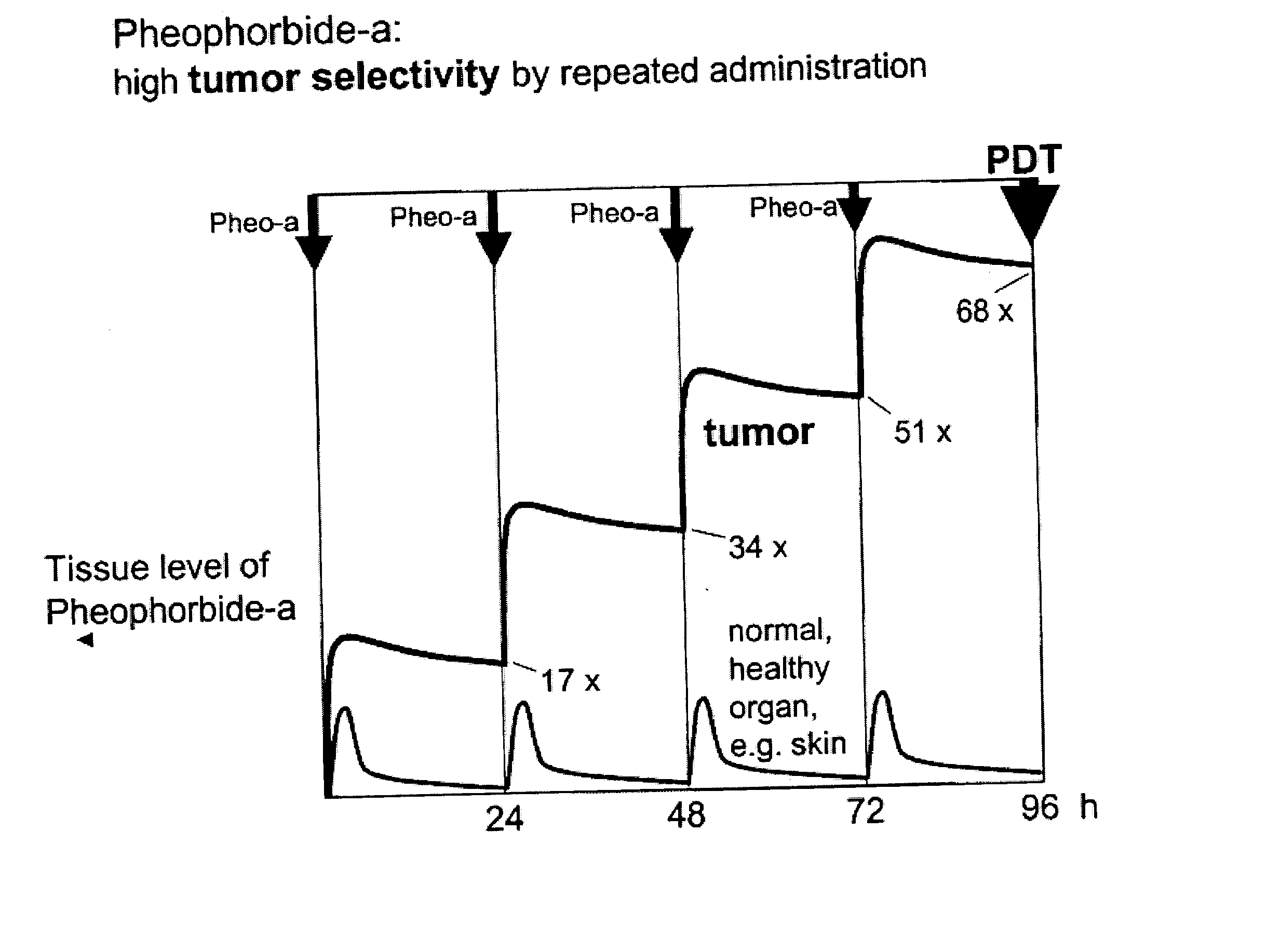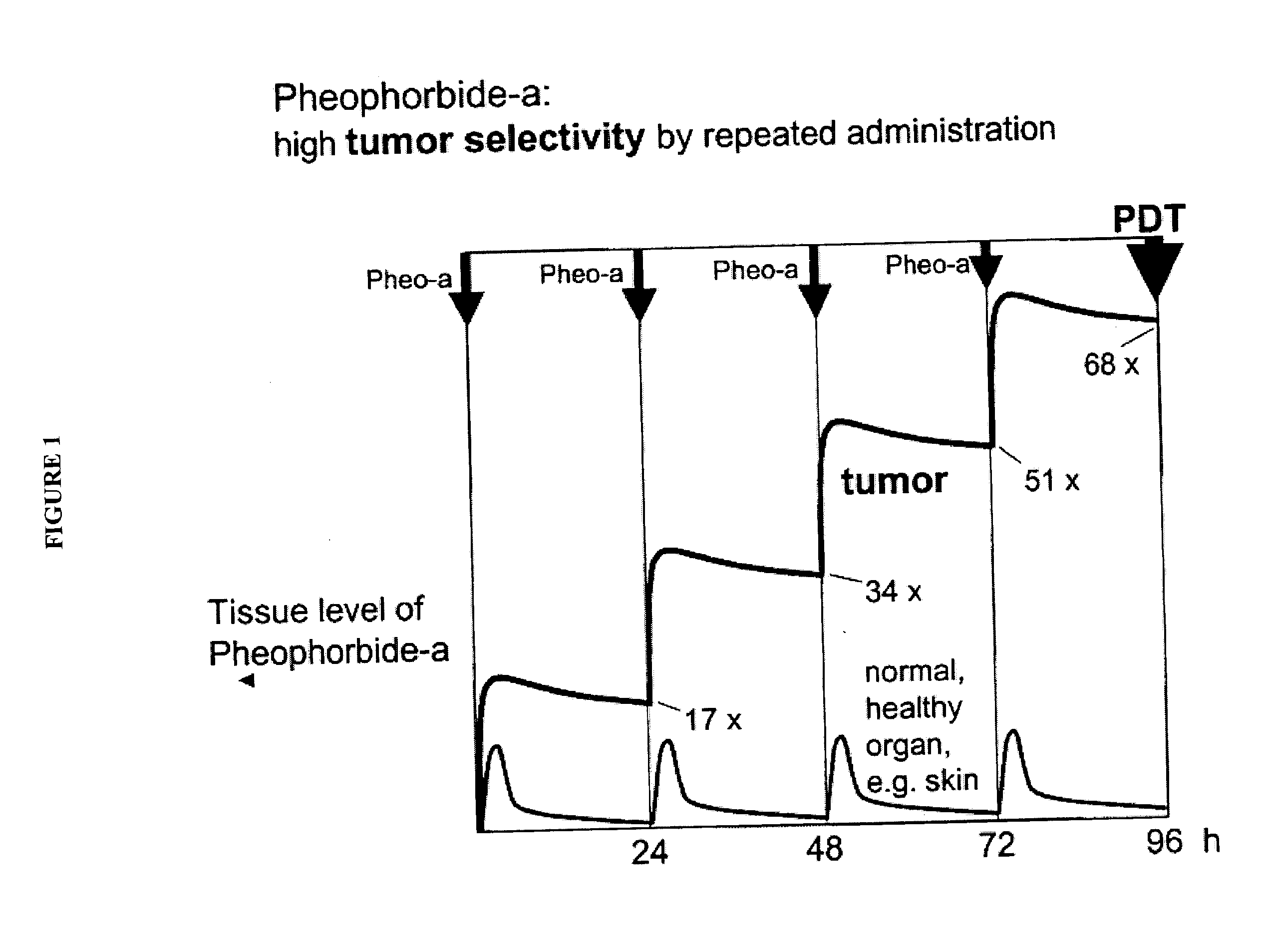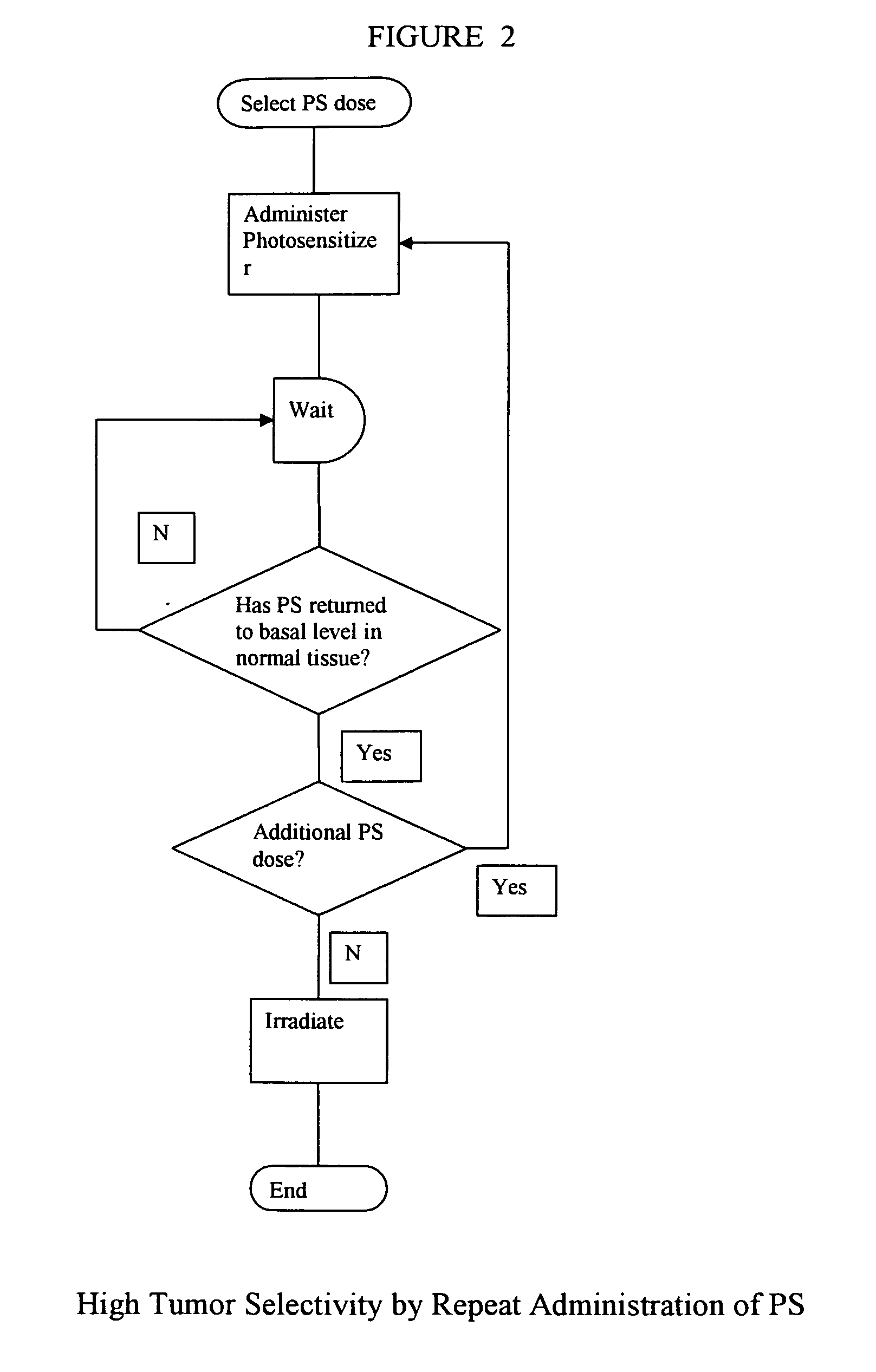Efficacy and safety of photodynamic therapy by multiple application protocols with photosensitizers that show extended tumor retention
a photodynamic therapy and tumor technology, applied in the field of photodynamic therapy, can solve the problems of inability to achieve satisfactory treatment, damage to both healthy and diseased cells in proximity, and the need for selective irradiation of malignant cells, so as to achieve the effect of improving efficacy and safety
Inactive Publication Date: 2004-09-30
BIOLITEC UNTERNEHMENSBETEILLIGUNGS II AG
View PDF7 Cites 1 Cited by
- Summary
- Abstract
- Description
- Claims
- Application Information
AI Technical Summary
Benefits of technology
[0005] In PDT, a photosensitizer (PS) is applied to the organism and is expected to accumulate in diseased hyperproliferative tissue to a greater extent than in normal tissue. This differential accumulation is due to several factors. In the blood, the PS is bound to plasma proteins to a varied extent. One of these plasma proteins is low density lipoprotein (LDL). LDL can be taken up by tumor cells, or other cells in hyperproliferative diseases to a higher extent than by normal cells. Therefore, a higher amount of PS is delivered to tumor cells or other hyperproliferating tissue. A further factor may be the altered capillary architecture in malignant tissue, leading to enhanced permeability of the capillaries. Furthermore, tumor tissue can have a lower pH than normal tissue. Low pH favors accumulation of PS with carboxylic groups, because these groups bind protons, thus leading to uncharged PS molecules that can penetrate biomembranes easier than charged PS. Another factor is decreased metabolism of the PS in malignant cells.
[0011] There is a need for a method to increase the concentration and selectivity of accumulation of photosensitizers in hyperproliferative or otherwise diseased tissue, both to increase the effectiveness of the treatment and more effectively protect healthy tissue from damage. The present invention addresses this need.OBJECTIVES AND BRIEF SUMMARY OF THE INVENTION
[0013] It is a further object of the present invention to provide a photodynamic therapy treatment method that produces higher and more selective concentrations of PS in diseased tissue than is possible with prior art methods.
Problems solved by technology
So far all known PS, when activated, cause damage to both healthy and diseased cells in their proximity.
Absence of differential PS accumulation would result in the need for selective irradiation of the malignant cells.
This is, however, generally not possible for a satisfactory treatment.
Furthermore, it is not possible to limit PDT effects in tissue depth exactly to the tumor.
It does not, however provide guidance to increase sensitivity in diseased tissue while maintaining or improving safety for normal tissue.
This method does not address how to improve efficacy of PDT treatments while maintaining or improving safety for normal tissue.
This method therefore does not address PhotoDynamic Therapy treatments.
It thus does not deal with how to improve efficacy of PDT treatments while maintaining or improving the safety for normal tissue.
Method used
the structure of the environmentally friendly knitted fabric provided by the present invention; figure 2 Flow chart of the yarn wrapping machine for environmentally friendly knitted fabrics and storage devices; image 3 Is the parameter map of the yarn covering machine
View moreImage
Smart Image Click on the blue labels to locate them in the text.
Smart ImageViewing Examples
Examples
Experimental program
Comparison scheme
Effect test
example 2
[0042] PDT of a Skin Tumor in a Patient that is Non-compliant with Skin Light Protection Measures.
[0043] PS administration is split over four administrations so that after each administration only a small peak PS concentration in the normal skin is reached, achieving a better light tolerance.
the structure of the environmentally friendly knitted fabric provided by the present invention; figure 2 Flow chart of the yarn wrapping machine for environmentally friendly knitted fabrics and storage devices; image 3 Is the parameter map of the yarn covering machine
Login to View More PUM
 Login to View More
Login to View More Abstract
A safer, improved method of photodynamic therapy is provided for treating diseased, hyperproliferative tissue, including cancer, psoriasis, and arthritis, using multiple, sequential administrations of a photosensitizer (PS) prior to irradiation. Preferred photosensitizers are characterized by being retained in the diseased tissue for a longer time than in normal tissue. The interval between administrations is chosen to be of sufficient duration to allow the PS content of normal tissues to drop to a basal or negligible level before the next administration and before irradiation. At that time, the PS content of the diseased tissue is still high, not less than half of the initial content after the last PS administration. In this way, PDT with better selectivity for the diseased tissue is achieved. With sequential PS administrations, the PS burden on normal tissue can be kept low, so that side effects can be reduced, for example damage of the skin by sunlight or bright indoors artificial lighting. The precise durations between PS administrations and eventual irradiation vary between treatments, and are determined on an individual basis. Preferred PS for use with the present invention have a high and extended localization in tumor tissue. A preferred PS with these qualities is pheophorbide a.
Description
[0001] 1. Field of the Invention[0002] This invention relates to photodynamic therapy of malignant tumors or diseased tissue with enhanced cellular proliferation using photosensitizing agents that accumulate selectively in the diseased tissue. In particular, the present invention relates to time-separated, multiple administrations of photosensitizer to enhance accumulation of the photosensitizer in diseased tissue to improve light sensitivity in the diseased tissue (efficacy) and to enhance the safety for normal tissue.[0003] Information Disclosure Statement[0004] Photodynamic therapy (PDT) is a well-known method for treatment of cancer and other hyperproliferative diseases. Such other hyperproliferative diseases comprise the skin disease psoriasis, as well as arthritis, a chronic inflammatory disease of the joints.[0005] In PDT, a photosensitizer (PS) is applied to the organism and is expected to accumulate in diseased hyperproliferative tissue to a greater extent than in normal ti...
Claims
the structure of the environmentally friendly knitted fabric provided by the present invention; figure 2 Flow chart of the yarn wrapping machine for environmentally friendly knitted fabrics and storage devices; image 3 Is the parameter map of the yarn covering machine
Login to View More Application Information
Patent Timeline
 Login to View More
Login to View More IPC IPC(8): A61N5/06
CPCA61N5/062A61N5/0601A61P17/06A61P19/02A61P35/00A61P43/00
Inventor BODE, HANS-PETERALBERCHT, VOLKER
Owner BIOLITEC UNTERNEHMENSBETEILLIGUNGS II AG
Features
- R&D
- Intellectual Property
- Life Sciences
- Materials
- Tech Scout
Why Patsnap Eureka
- Unparalleled Data Quality
- Higher Quality Content
- 60% Fewer Hallucinations
Social media
Patsnap Eureka Blog
Learn More Browse by: Latest US Patents, China's latest patents, Technical Efficacy Thesaurus, Application Domain, Technology Topic, Popular Technical Reports.
© 2025 PatSnap. All rights reserved.Legal|Privacy policy|Modern Slavery Act Transparency Statement|Sitemap|About US| Contact US: help@patsnap.com



